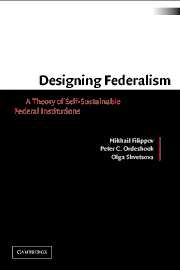Book contents
- Frontmatter
- Contents
- List of Figures
- List of Tables
- Preface
- Acknowledgments
- 1 Federations and the Theoretical Problem
- 2 Federal Bargaining
- 3 Two Cases of Uninstitutionalized Bargaining
- 4 Representation
- 5 Incentives
- 6 Political Parties in a Federal State
- 7 Institutional Sources of Federal Stability I
- 8 Institutional Sources of Federal Stability II
- 9 Designing Federalism
- References
- Name Index
- Subject Index
7 - Institutional Sources of Federal Stability I
Published online by Cambridge University Press: 03 December 2009
- Frontmatter
- Contents
- List of Figures
- List of Tables
- Preface
- Acknowledgments
- 1 Federations and the Theoretical Problem
- 2 Federal Bargaining
- 3 Two Cases of Uninstitutionalized Bargaining
- 4 Representation
- 5 Incentives
- 6 Political Parties in a Federal State
- 7 Institutional Sources of Federal Stability I
- 8 Institutional Sources of Federal Stability II
- 9 Designing Federalism
- References
- Name Index
- Subject Index
Summary
The balance of social interests, the separation and balance of powers, were meant to secure liberty, but it was still uncertain, after the instrument had been framed and ratified, whether the balance would not be too precarious to come to rest anywhere; and whether the arms of government, separated in parchment, could come together in reality to cooperate in the formation and execution of policy.
Hofstadter 1969: 70The constitution of the United States is an admirable work, nevertheless one may believe that its founders would not have succeeded, had not the previous 150 years given the different States of the Union the taste for, and practice of, provincial governments.
Alexis de ToquevilleI confess, as I enter the Building, I stumble on the threshold. I meet with a National Government, instead of a Federal Union of Sovereign States.
Samuel Adams 1787, on the U.S. ConstitutionIntroduction
Adams can be forgiven his initial cynical assessment of the newly proposed Constitution since he played the critical role in ensuring its approval by the Massachusetts ratifying convention. His cousin John, on the other hand, was perhaps less enthusiastic of its possibilities, for Adams “knew full well the dependence of republicanism on the character of the people” (Wood 1969: 570) and in this respect he was more than a little apprehensive of the future.
- Type
- Chapter
- Information
- Designing FederalismA Theory of Self-Sustainable Federal Institutions, pp. 226 - 258Publisher: Cambridge University PressPrint publication year: 2004



